There’s something inherently enchanting about cats with bushy tails. These majestic creatures capture our hearts not just with their playful antics but also with their luxurious tails that add an extra flair to their appearance.
Exploring the diversity among cat breeds with bushy tails reveals a fascinating world of feline beauty and charm. Whether you’re captivated by the mystique of a black cat with a bushy tail or the elegance of a white cat with a fluffy tail breed, there’s a breed that embodies the allure of bushy-tailed felines.
This article dives deep into the bushy-tailed cat breeds, offering a detailed look at their characteristics, care needs, and why they stand out from the rest.
1. Siberian (Black Cat with Bushy Tail)

The Siberian, a natural breed from the forests of Russia, is renowned for its robust health, hearty nature, and beautiful bushy tail. While they come in various colours and patterns, the black cat with a bushy tail variant of the Siberian is particularly striking, featuring a luxuriously dense, water-repellent coat that’s perfect for anyone seeking a majestic wild cat with a bushy tail.
Fun Fact:
- Siberians have a layer of fur that is almost waterproof, thanks to their origin in the cold, harsh climates of Siberia, making them well-suited for adventures both indoors and out.
- This breed is known for its hypoallergenic qualities, making it a popular choice among cat lovers with allergies.
- Siberians mature slowly, reaching full physical maturity at around 5 years of age, which is somewhat later than many other cat breeds.
2. Maine Coon (The Gentle Giants)
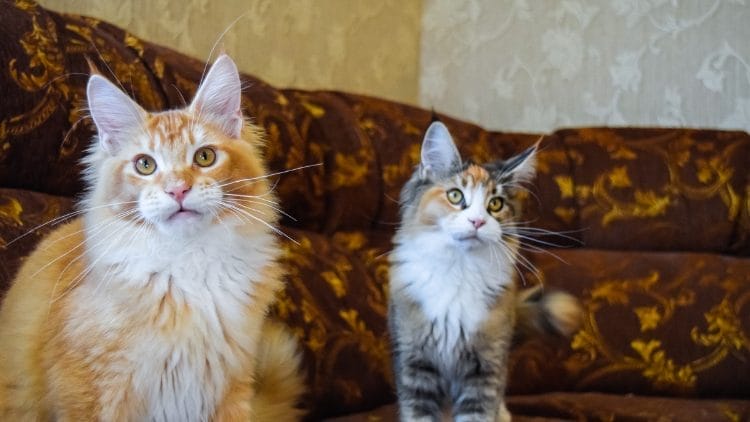
The Maine Coon, known for its size and luxuriant bushy tail, is a gentle giant with a friendly disposition. Originating from the United States, this breed’s impressive tail helps it navigate the cold, showcasing its adaptability and strength. With a personality as grand as its appearance, the Maine Coon makes a loving companion for families and individuals alike.
Fun Fact:
- Maine Coons are known for their “dog-like” characteristics, including playing fetch and greeting their owners at the door.
- They have tufted ears and feet that act like natural snowshoes, helping them navigate through snow with ease.
- The longest domestic cat ever recorded was a Maine Coon named Stewie, measuring over 4 feet in length!
3. Norwegian Forest Cat (The Nordic Beauties)

With roots in Northern Europe, the Norwegian Forest Cat is built for chilly climates. Its thick, bushy tail, which it can wrap around itself for warmth, is just one of its many adaptations. These cats are known for their adventurous spirit and friendly nature, making them perfect pets for those looking for a hearty and affectionate feline friend.
Fun Fact:
- Norwegian Forest Cats were believed to be the pets of Vikings, travelling with them on their longboats.
- They have a unique double coat that is waterproof, helping them stay dry and warm in harsh climates.
- Despite their wild appearance, “Wegies,” as they are affectionately known, have a very gentle and friendly demeanour.
4. Siberian Cat (The Russian Feline Royalty)
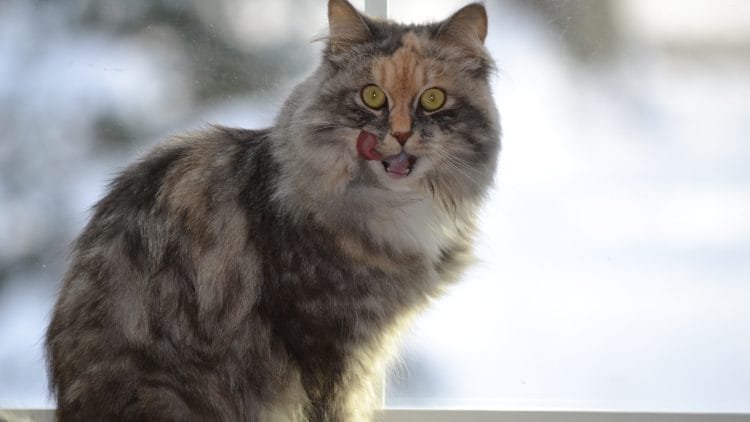
The Siberian cat, boasting a lush bushy tail, is renowned for its hypoallergenic fur, making it a favorite among allergy sufferers. Originating from Russia, this breed combines robust health with a playful and affectionate temperament, embodying the majesty and resilience of its homeland.
Fun Fact:
- Siberian cats have been around for over a thousand years in Russia, appearing in many Russian fairy tales and legends.
- They have a remarkable jumping ability and can leap higher than most other cat breeds.
- Siberians develop slowly, taking up to 5 years to reach their full size and coat development.
5. Persian Cat (The Elegance Personified)
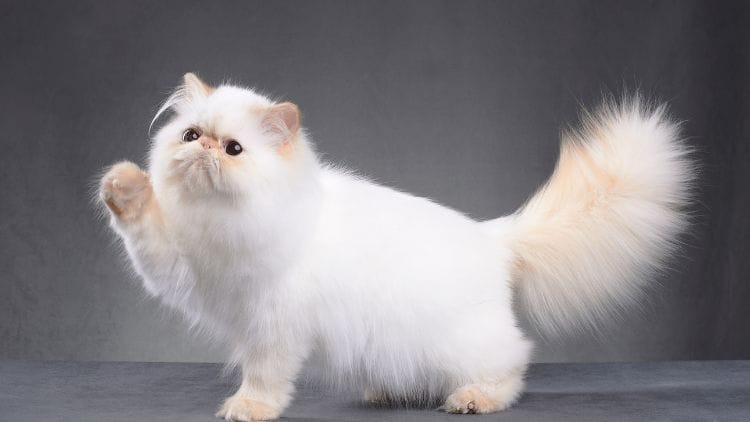
Persian cats are synonymous with luxury, and their bushy tails are a big part of their elegant appeal. Known for their long, luxurious coats, Persians require regular grooming to maintain their beauty. Gentle and serene, Persian cats offer a dignified companionship to those willing to meet their care needs.
Fun Fact:
- Persian cats were once the most popular cat breed in the United States for many years.
- They have a wide variety of colours and patterns, including the famous “Himalayan” pattern, which is a crossbreed between Siamese and Persian.
- The first Persian cat was presented in Europe at Italy’s first-ever cat show in 1871.
6. American Bobtail (The Wild Look with a Soft Heart)
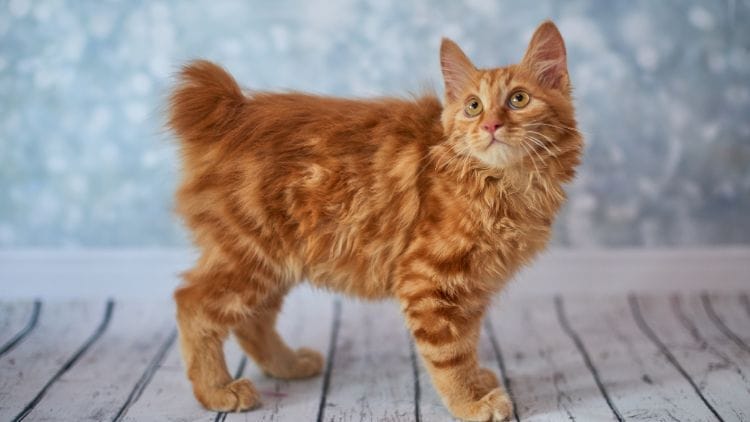
The American Bobtail, notable for its shorter, bushy tail, gives off a wild appearance that belies its sweet nature. This breed is incredibly adaptable and bonds well with families, making it a wonderful choice for a household pet. Their unique tails add to their charm and distinctiveness.
Fun Fact:
- The American Bobtail’s tail is actually a genetic mutation, and the length can vary from one-third to one half the length of a normal cat’s tail.
- They are known for their “escape artist” abilities, often being able to open closed doors and windows.
- This breed is relatively new, developed in the late 1960s from a domestic tabby and a bobtailed wildcat.
7. Turkish Van (The Swimming Cat)
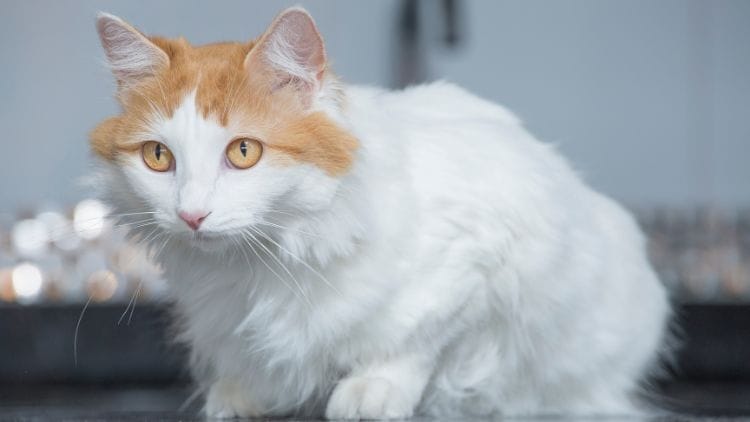
The Turkish Van is not only known for its Fluffy tail but also for its love of water. This rare trait, coupled with its playful and energetic demeanour, makes the Turkish Van a unique and delightful companion. Its distinctive coat and tail require minimal grooming, making it a low-maintenance option for busy owners.
Fun Fact:
- The Turkish Van is one of the few cat breeds that enjoys swimming, attributed to its waterproof coat.
- This breed is named after the Lake Van region in Turkey, where they are believed to have originated.
- Turkish Vans are sometimes called “the cat of Noah’s Ark” because legend has it that they were aboard Noah’s Ark and swam ashore from the boat.
8. Balinese (The Long-Haired Siamese)

The Balinese is essentially a long-haired Siamese, boasting a silky, flowing coat and an elegantly bushy tail. This breed is known for its striking blue eyes and svelte physique.
- Despite their aristocratic appearance, Balinese cats are playful and affectionate, often forming strong bonds with their human companions.
- They are one of the most vocal cat breeds, known for their chatty nature and loud voices.
9. Ragdoll (The Floppy Cat)
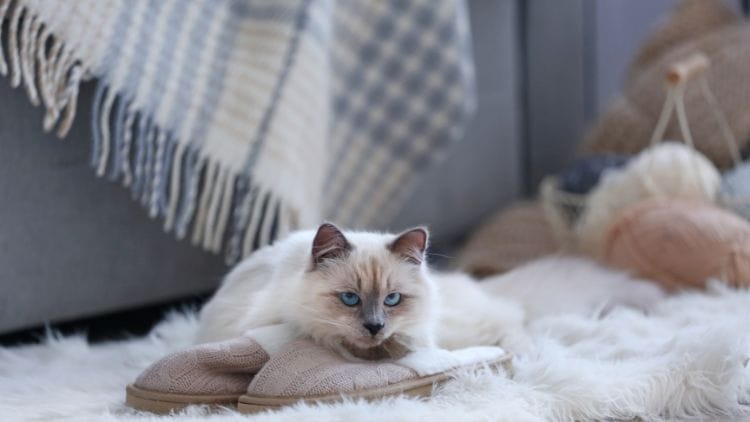
Ragdolls are large, laid-back cats with striking blue eyes, semi-long coats, and bushy tails. They are known for going limp when picked up, hence the name “Ragdoll.”
Fun Facts
- Ragdolls are often described as “dog-like” cats because of their tendency to follow their owners around and greet them at the door.
- They are slow growers, reaching full maturity and size around 4 years of age.
10. Birman (The Sacred Cat of Burma)
Birmans are medium to large-sized cats with semi-long, silky fur and a plumed tail. They have striking blue eyes and a gentle expression.
Fun Facts
- Legend has it that Birmans were the sacred temple cats of Burma, companions to priests.
- They are known for their exceptional social skills, often getting along well with children and other pets.
11. Somali (Short Hair Cat with Fluffy Tail)
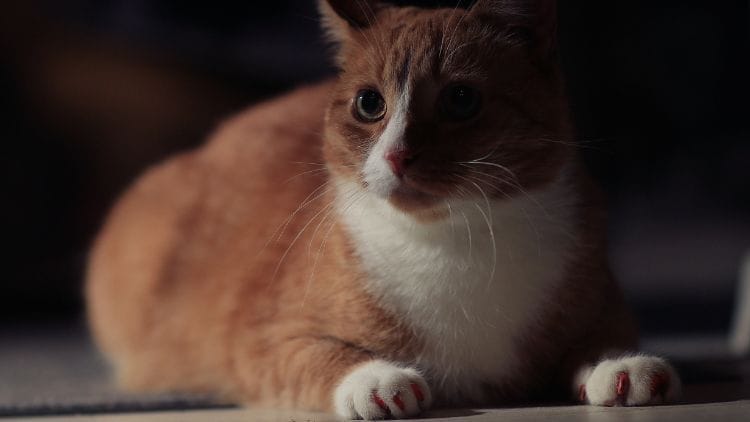
The Somali cat is essentially a long-haired version of the Abyssinian, with a bushy tail, large ears, and a ticked coat. They are known for their playful and curious nature.
Fun Facts
- Somalis are often called “little foxes” because of their bushy tails and agile, cunning behaviour.
- Despite their exotic appearance, Somalis are quite affectionate and enjoy being part of family activities.
12. Cymric (The Long-Haired Manx)
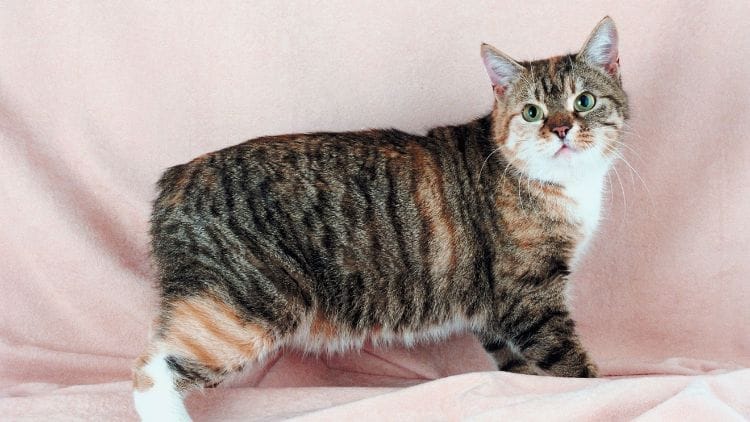
The Cymric is a long-haired variant of the Manx cat, known for its round body, short tail, or complete taillessness, and a dense, bushy tail in those with tails.
Fun Facts
- Cymrics are known for their ability to perform “bunny hops” due to their unique hind leg structure.
- They are incredibly skilled hunters, often surprising their owners with their prowess.
13. Scottish Fold Longhair (The Floppy-Eared Poof)
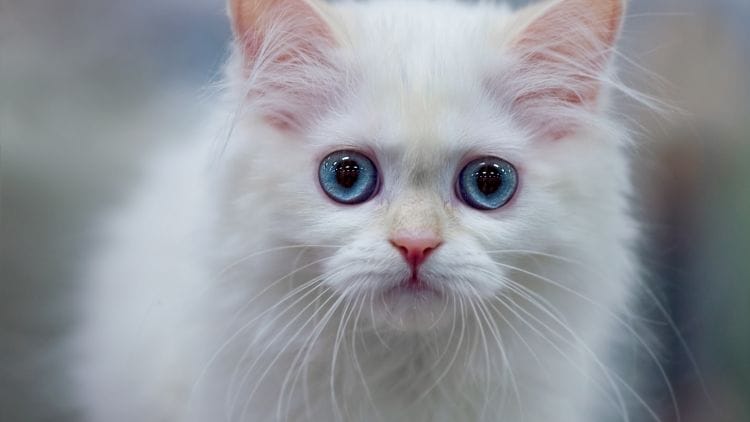
This breed is the long-haired version of the Scottish Fold, featuring the breed’s signature folded ears and a long, bushy tail. They have a sweet, calm demeanour.
Fun Facts
- The fold in their ears is caused by a genetic mutation that affects cartilage throughout the body, including the tail.
- Scottish Fold Longhairs are known for their “owl-like” appearance and can often be found sitting in the “Buddha position,” with their legs stretched out and their paws on their belly.
14. Himalayan (The Persian Siamese Blend)

The Himalayan, or Himmie, is a cross between a Persian and a Siamese, featuring the long, luxurious coat and bushy tail of the Persian and the colour points of the Siamese.
Fun Facts
- Himalayans enjoy a laid-back lifestyle, often found lounging in the sun or seeking out the warmest spot in the house.
- They have a sweet, mild-mannered temperament, making them excellent companions for a quiet home.
The Importance of Grooming for Fluffy-Tailed Breeds
Maintaining a bushy tail in all its glory involves regular grooming. This section provides essential tips for keeping your cat’s tail fluffy and healthy, highlighting the importance of grooming in preventing mats and tangles.
The Enchantment of Fluffy Tails in Cats
Bushy tails in cats are more than just a visual delight; they’re a testament to nature’s artistry. The aesthetic appeal of a full, fluffy tail waving gracefully with each movement can have a calming effect, making these cats highly sought after.
Beyond beauty, the business of a cat’s tail can also serve as a mood indicator and play a significant role in balance and communication.
Behavioural Traits and Personality Differences
The size and business of a cat’s tail can offer insights into its mood and behaviour. This segment explores how bushy-tailed breeds interact with their environment, other pets, and children, offering potential owners a glimpse into their world.
Adopting a Bushy-Tailed Cat: What to Know
Adopting a cat with a bushy tail comes with its own set of considerations. This part of the article guides readers through the adoption process, from understanding the breed’s needs to creating the perfect home environment.
FAQs About Bushy-Tailed Cat Breeds
What makes a cat’s tail bushy?
The business of a cat’s tail is largely determined by genetics. The density of fur, length of the hair, and overall health of the cat play significant roles. Some breeds naturally have bushier tails due to their ancestry and breed characteristics.
Are bushy-tailed cats more difficult to groom?
Yes, bushy-tailed cats can require more grooming effort to prevent mats and tangles. Regular brushing, ideally several times a week, is recommended to keep their tails in good condition. However, grooming can also be a bonding experience for you and your pet.
Do bushy-tailed cat breeds get along with other pets?
Personality varies by individual, but many bushy-tailed cat breeds are known for their sociable and friendly nature. For example, Maine Coons are often very good with other pets and children, making them excellent family pets. It’s always a good idea to introduce pets to each other gradually and under supervision.
Can bushy-tailed cats live in warm climates?
Yes, many bushy-tailed cats can adapt to various climates. However, it’s important to ensure they have a cool, shaded place to retreat to during hot weather. Breeds like the Siberian and Norwegian Forest Cats have coats that adapt to seasonal changes, getting lighter in the warm months.
Are all bushy-tailed cats large breeds?
Not necessarily. While some bushy-tailed breeds like the Maine Coon and Norwegian Forest Cat are on the larger side, others, such as the American Bobtail, can be medium-sized. The business of the tail is not directly related to the overall size of the cat.
How can I adopt a bushy-tailed cat?
Bushy-tailed cats can be adopted from breeders, shelters, and rescue organizations. When looking to adopt, consider checking local shelters and rescue groups first, as they often have cats in need of homes. If you’re looking for a specific breed, research reputable breeders who prioritize health and temperament.
Do bushy-tailed cats have any specific health issues?
Like all breeds, bushy-tailed cats can be prone to certain genetic health conditions. It’s important to obtain cats from sources that conduct proper health screenings. Regular veterinary check-ups are essential for maintaining their health, regardless of tail business.
Conclusion
Cat breeds with bushy tails offer a unique combination of beauty, companionship, and intrigue. Whether you’re drawn to the majestic Maine Coon or the playful Turkish Van, there’s a bushy-tailed breed to suit every preference and lifestyle.


You May Also Read